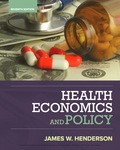Pharmaceutical Benefits Managers (PBMs) are intermediaries between upstream drug manufacturers and downstream insurance companies. They design formularies (lists of drugs that insurance will cover) and negotiate prices with drug companies. PBMs want a wider variety of drugs available to their insured populations, but at low prices. Suppose that a PBM is negotiating with the makers of two nondrowsy allergy drugs, Claritin and Allegra, for inclusion on the formulary. The “value” or “surplus” created by including one nondrowsy allergy drug on the formulary is $80 million, but the value of adding a second drug is only $24 million. Assume the PBM bargains by telling each drug company that it's going to reach an agreement with the other drug company. Under the non-strategic view of bargaining, the PBM would earn a surplus of _____________ million, while each drug company would earn a surplus of _______________ million. Now suppose the two drug companies merge. What is the likely postmerger bargaining outcome? Under the nonstrategic view of bargaining, the PBM would earn a surplus of __________________ million, while the merged drug company would earn a surplus of ___________________
Pharmaceutical Benefits Managers (PBMs) are intermediaries between upstream drug manufacturers and downstream insurance companies. They design formularies (lists of drugs that insurance will cover) and negotiate prices with drug companies. PBMs want a wider variety of drugs available to their insured populations, but at low prices. Suppose that a PBM is negotiating with the makers of two nondrowsy allergy drugs, Claritin and Allegra, for inclusion on the formulary. The “value” or “surplus” created by including one nondrowsy allergy drug on the formulary is $80 million, but the value of adding a second drug is only $24 million. Assume the PBM bargains by telling each drug company that it's going to reach an agreement with the other drug company. Under the non-strategic view of bargaining, the PBM would earn a surplus of _____________ million, while each drug company would earn a surplus of _______________ million. Now suppose the two drug companies merge. What is the likely postmerger bargaining outcome? Under the nonstrategic view of bargaining, the PBM would earn a surplus of __________________ million, while the merged drug company would earn a surplus of ___________________
Managerial Economics: A Problem Solving Approach
5th Edition
ISBN:9781337106665
Author:Luke M. Froeb, Brian T. McCann, Michael R. Ward, Mike Shor
Publisher:Luke M. Froeb, Brian T. McCann, Michael R. Ward, Mike Shor
Chapter16: Bargaining
Section: Chapter Questions
Problem 16.6IP
Related questions
Question
Pharmaceutical Benefits Managers (PBMs) are intermediaries between upstream drug manufacturers and downstream insurance companies. They design formularies (lists of drugs that insurance will cover) and negotiate prices with drug companies. PBMs want a wider variety of drugs available to their insured populations, but at low prices. Suppose that a PBM is negotiating with the makers of two nondrowsy allergy drugs, Claritin and Allegra, for inclusion on the formulary. The “value” or “surplus” created by including one nondrowsy allergy drug on the formulary is $80 million, but the value of adding a second drug is only $24 million.
Assume the PBM bargains by telling each drug company that it's going to reach an agreement with the other drug company.
Under the non-strategic view of bargaining, the PBM would earn a surplus of _____________
million, while each drug company would earn a surplus of _______________
million.
Now suppose the two drug companies merge. What is the likely postmerger bargaining outcome?
Under the nonstrategic view of bargaining, the PBM would earn a surplus of __________________
million, while the merged drug company would earn a surplus of ___________________
million.
Expert Solution
This question has been solved!
Explore an expertly crafted, step-by-step solution for a thorough understanding of key concepts.
This is a popular solution!
Trending now
This is a popular solution!
Step by step
Solved in 3 steps

Knowledge Booster
Learn more about
Need a deep-dive on the concept behind this application? Look no further. Learn more about this topic, economics and related others by exploring similar questions and additional content below.Recommended textbooks for you

Managerial Economics: A Problem Solving Approach
Economics
ISBN:
9781337106665
Author:
Luke M. Froeb, Brian T. McCann, Michael R. Ward, Mike Shor
Publisher:
Cengage Learning


Economics (MindTap Course List)
Economics
ISBN:
9781337617383
Author:
Roger A. Arnold
Publisher:
Cengage Learning

Managerial Economics: A Problem Solving Approach
Economics
ISBN:
9781337106665
Author:
Luke M. Froeb, Brian T. McCann, Michael R. Ward, Mike Shor
Publisher:
Cengage Learning


Economics (MindTap Course List)
Economics
ISBN:
9781337617383
Author:
Roger A. Arnold
Publisher:
Cengage Learning


